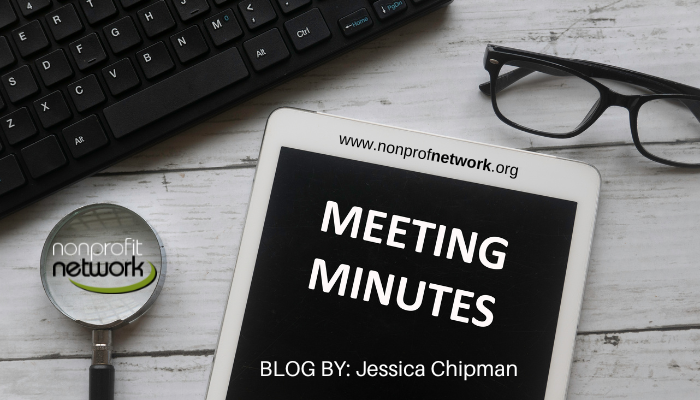
 Jessica Chipman
Jessica Chipman
Office Manager
Many people can relate to sitting in an unproductive meeting. However, meetings do not have to be a waste of time. If accurate minutes are kept and clear-cut action steps are identified, then hours spent in a meeting can lead to a productive outcome.
Taking quality minutes at a meeting is very important. High-quality minutes are a powerful tool that you can leverage to do the following—
- Help refresh key points from the last meeting
- Offer background information for those that could not attend the meeting
- Summarize decisions made
- Identify goals and point out clear action steps
- Provide organization and structure
- Act as a historical record and may offer legal protection
Minutes play a crucial part in any meeting. Here are key components that should always be part of your minutes:
1) Agenda
Before the meeting, an agenda should be sent to all those involved in the meeting. Having an agenda before the meeting not only helps keep the meeting on track, but also makes it easier for the notetaker to follow along and take accurate minutes. The best part is that meeting minutes can be taken and put right into the agenda.
2) Type of Meeting, Date, Start and End Time
The heading of the minutes should indicate the type of meeting being held (for example: Board Meeting, Finance Committee Meeting, etc.). The minutes should also contain the date the meeting took place, the time the meeting started, and the time the meeting ended.
3) Attendees/Excused
Everyone that attended the meeting and those that were excused/absent should be listed in the minutes.
4) Key Discussion Points
Important parts of the conversation during the meeting should be well documented.
5) Action Items
To-dos or outcomes from the conversation should be clearly outlined.
6) Motions/Approvals
When voting takes place, it is important to keep a record of who motioned, seconded the motion, and if the vote was approved or not approved by the group.
7) Time/Date/Location of Next Meeting (if reoccurring or if decided during the meeting)
This allows everyone to know when the next meeting will take place.
After the meeting minutes are proofread and finalized, the note-taker should make sure the minutes are signed by the appropriate person (such as the secretary of the board) if necessary. Once finalized, the minutes should be sent to everyone that attended the meeting as soon as possible.
Well-documented meeting minutes can help turn discussion into decisions, and decisions into results. At your next meeting, make sure quality meeting minutes are kept—ensure that the hours spent in discussion can lead to a positive outcome.
Do you want to see a sample of meeting minutes that demonstrate the suggestions above? Email [email protected] to let us know you're interested, and we'll share a resource with you! No strings attached.
Want even more? Click here to sign up for our weekly e-newsletter. Each week you'll get a link to the most recent news, workshops, and sector updates. We promise to respect your time and will not flood your inbox. We only send one e-newsletter each week and when any timely important announcements need to be made.

